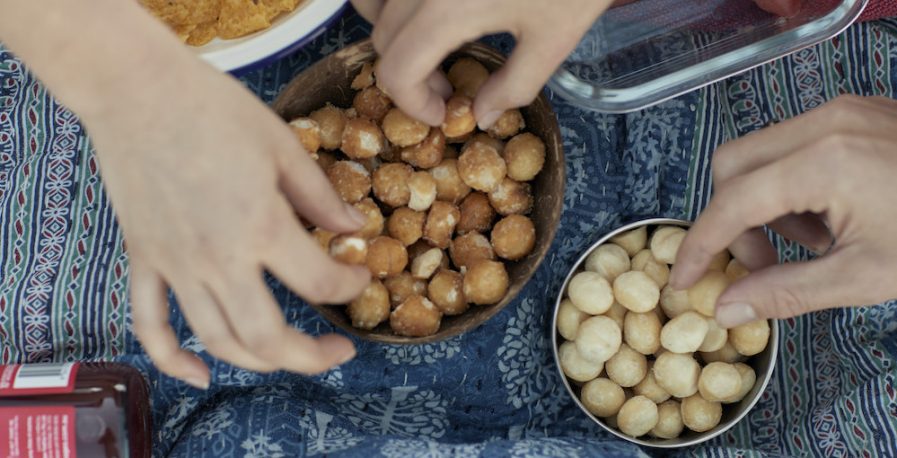Watching new flavour combinations emerge is always fascinating – especially when macadamias are involved – and three recent discoveries out of Europe immediately caught our attention.

Before diving into the who, what and where of these products (hint: involves fruit, herb, tea and liquor flavours), we take a quick look at what’s happening in the world of snack flavours across Europe, and finish with some insights into how COVID-19 may impact flavour innovation more broadly in the coming years.
Salt down, more adventurous snack nut flavours up across Europe
According to Innova Market Insights1, Europe ranked second for new product development (NPD) in both the snack nuts (34%) and snacks categories (27%) last year, behind Asia which represented 39% and 44% respectively.
Germany launched the most new snack nut products of all European countries, with growth driven by packaging innovation, portion control, smoked and roasted flavours, fruit additions and indulgent sweet flavours such as caramel, maple and milk chocolate.
While salt was the top flavour seen in European snack nut NPD last year, its share has dropped markedly from 20% of NPD in 2017 to just 5% in 2019, amid rising consumer interest in more novel flavours , and concerns about the health implications of salt consumption.
Chilli, honey and paprika were the next most popular flavours last year, with bacon, barbecue, coconut, soy sauce, rosemary, berry, matcha tea, Japanese miso, and turmeric flavours also becoming more prevalent.
Trending snack nut flavours varied between markets across Europe in 2019, making for an interesting cross-section of innovative snacking flavours:
- Germany: rosemary, bourbon, vanilla, cranberry, nacho cheese, coconut
- France: black pepper, thyme, Espellete chilli, smoked, sour cream
- Spain: truffle mushrooms, cayenne pepper, beef hamburger, bacon
- Netherlands: green pesto, bacon, seaweed
Macadamias marry with unique new flavours
German manufacturer Kern Energie is a popular producer of individual snack mixes with nuts, seeds and fruits. Its 2020 Easter collection featured two macadamia products – Raspberry-Thyme Bubbles and Strawberry-Rosemary Roasted Bubbles. The beautiful blush coloured products consist of macadamia kernel coated in a raspberry or strawberry dust with a hint of thyme or rosemary, and are described as “a combination of the buttery soft macadamia, and the slightly acidic coating of the freeze-dried fruits and herbs”. Their taste and texture are “fruity sweet, spicy and wonderfully crisp”, which is said to make them an ideal accompaniment to a gin and tonic. We’ll drink to that.
The nu company GmbH is a social food start-up which plants a tree with every product sold. Specialising in cereal and chocolate bars, and natural protein shakes (all in plastic-free packaging), the brand recently launched the nucao Macadamia Chai chocolate bar, featuring a marriage of macadamia nuts and spices including cinnamon, cardamom and cloves. The brand describes its chocolate as ‘the first candy bar that you can enjoy with a clear conscience” and features 65% less sugar than regular chocolate, appealing to consumers seeking sustainable and healthy products that also deliver on indulgence.
Guillaume Vincent Chocolatier, a high-end French chocolate brand renowned for creative and unique products, recently launched a decadent Coffee & Irish Cream Caramel spread, described as a “fusion of smooth caramel and macadamias that delivers a fine flavour reminiscent of coconut and vanilla bourbon.” Delivering an “incomparable fragrance and exquisite taste” it also contains a natural chicory extract that gives it a lower fat content than many classic spreads.

Has COVID cancelled flavour innovation?
Asian fusion foods and health convenience were hallmarks of 2019’s food product innovation and Innova Market Insights2 says that while ‘wilder and stranger novelty flavours’ were predicted to emerge in 2020, the script is being rewritten by the social restrictions and economic disruption of COVID-19.

Four effects of the pandemic have been identified as having an impact on flavour trends and innovation in the next few years.
- Household incomes and dining out: the hospitality sector was hit hard by the pandemic, and even as restaurants begin to re-open, the economic strain many are enduring may compromise people’s financial capacity to eat out. The catering and high-end restaurant trades have traditionally been initiators of new cuisines and flavours that gain mass appeal, and in turn, influence flavour in NPD.
- Travel bans: travel has long inspired the search for ‘exotic and way out flavours and formats’. Being unable to travel in search of new tastes and cultures may see exotic flavour innovation slow.
- Supply chain disruption: product developers may need to alter innovation plans to account for the strain the pandemic has placed on some ingredient supply chains.
- Olympic Games postponement: the 2020 Tokyo Olympic Games were expected to trigger increased interest in Japanese flavours. This will now be delayed until 2021.
Despite this, Innova Market Insights predicts new product and flavour formulations will continue, with new flavour development remaining one of the most effective ways for a brand to broaden its appeal or refresh a range. Flavour provides a point of difference, a hook for powerful messaging, and ensures a brand is perceived as fresh and innovative.
1: Innova Market Insights, Snack Nuts & Seeds in Europe 2019, Analysis of Snack Nuts & Seeds subcategory NPD in Europe
2: Innova Market Insights, “Out There” Flavors: Has the Future Been Postponed? 2020


